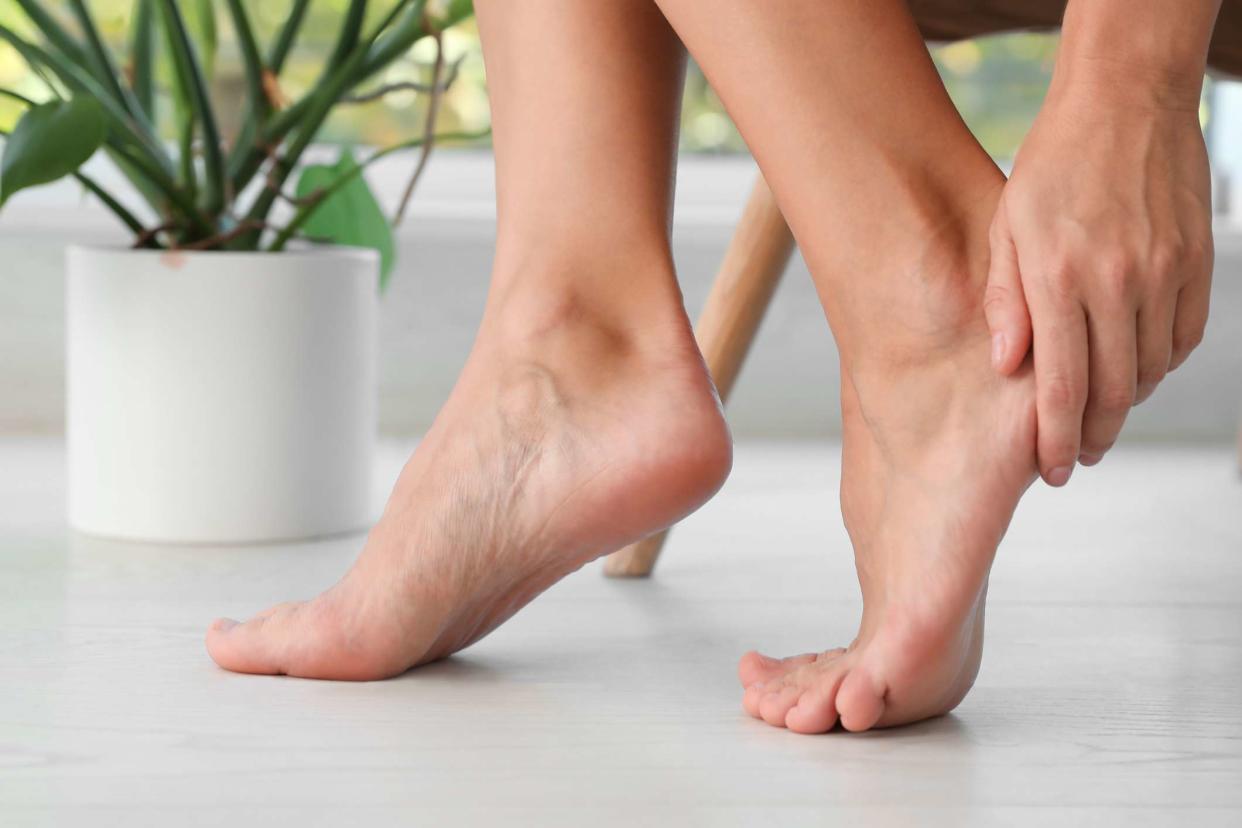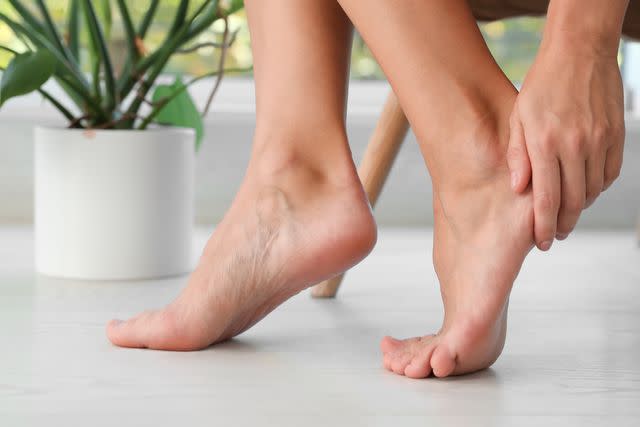10 Unusual Symptoms of Ankylosing Spondylitis

Medically reviewed by Stella Bard, MD
Ankylosing spondylitis (AS) is a type of arthritis that mainly affects the joints in your lower back. Common symptoms include joint pain and stiffness in the sacroiliac joints, where your pelvis connects to your lower spine.
AS is a systemic disease (throughout the entire body) that can affect body organ systems other than the joints in your back. The disease also varies in its effect from person to person. Some people have symptoms that uncommon to AS.
Knowing the less common signs of ankylosing spondylitis can help you achieve better outcomes since early treatment gives you the best chance of relieving symptoms and slowing the progress of the disease.
This article describes what to look concerning the 10 unusual symptoms that can occur with ankylosing spondylitis.

Iritis
Iritis, also known as anterior uveitis, is when the front part of one eye becomes swollen and red. It is the most common symptom of ankylosing spondylitis occurring outside the joints.
Anterior uveitis occurs in 20% to 30% of people with ankylosing spondylitis. Posterior uveitis, which affects the retina and/or the optic nerve, rarely occurs.
Regular checkups with a healthcare provider can help you recognize the early signs of vision damage to avoid permanent vision problems and delays in diagnosing ankylosing spondylitis. Without treatment, uveitis can cause permanent vision damage and possibly lead to vision loss.
Uveitis in ankylosing spondylitis can cause the following symptoms:
Photophobia (light sensitivity)
Increased tears
Heel Pain
In addition to the joints, ankylosing spondylitis can cause inflammation in the entheses, the area of the body where connective tissue such as ligaments and tendons attach to the bones. Inflammation of the entheses is called enthesitis, and the tender sites are often called hot spots.
The heel is a common location of enthesitis for people with ankylosing spondylitis. The plantar fascia at the base of the heel and sole of the foot and the Achilles tendon at the back of the heel can become inflamed, causing sharp pain and difficulty walking.
Irregular Nails
Ankylosing spondylitis and other forms of spondyloarthritis can present with skin manifestations, including nail bed inflammation. The impact is most common when proof of enthesitis is seen on an ultrasound.
Psoriatic nail disease most commonly occurs with psoriatic arthritis, though other rheumatic diseases like ankylosing spondylitis can also develop irregular nails. These symptoms include:
Pitting: Small holes or depressions in the nail surface
Onycholysis: Separation of the nail from the nail bed
Ridging: Raised lines that run vertically on the surface of the fingernail and, less commonly, horizontally
Nail plate crumbling
Discoloration under the nail or at the base of the nail
Learn More:Overview of Nail Psoriasis
Chest Pain
Ankylosing spondylitis can cause chest pain due to inflammation of the cartilage around the bones in your rib cage. This condition, called costochondritis, can occur when there is damage to the joints between the ribs and spine or where the ribs meet the breastbone in the front of your chest.
When this type of chest pain strikes, it can range from mild to severe. When pain is mild, you may feel heightened tenderness in the affected area. However, when severe pains are felt in your chest and down your arms. This pain resembles the heavy chest pain associated with an acute heart attack. It can worsen when you take a deep breath.
Chest pain from ankylosing spondylitis can last a few hours to several weeks. Because the pain resembles a heart attack and can interfere with normal breathing, you should have the pain assessed by a healthcare provider to confirm its source.
Chest pain can indicate a heart attack. If you have one or more of the following symptoms, call 911 or get immediate emergency medical care:
Uncomfortable tightness, pressure, squeezing, burning, or pain in the center of your chest that lasts more than a few minutes or goes away and returns
Uncomfortable sensations such as pain, pinching, numbness in one or both arms, your neck, back, shoulder blades, jaw, or stomach
Sudden aching, heaviness, or weakness in one or both arms
Difficulty breathing or shortness of breath
Dizziness, light-headedness, or disorientation
Sudden nausea or vomiting
Unusual fatigue
Unexplained heat/flushing or cold, clammy skin
Bluish color of your skin, nails, or lips
Difficulty Breathing
Difficulty breathing occurs in ankylosing spondylitis as a result of lung disease or chest wall abnormalities when the disease affects the joints of your rib cage. Both conditions result in restrictive lung function that prevents the full expansion of your chest when you breathe.
As your body curves forward and the effect of ankylosing spondylitis stiffens your chest wall, it can be difficult and painful to expand your chest. The disease can also cause an increased risk of lung infection and pulmonary fibrosis, which is scarring of the lungs. When combined with chest tightness, the effect can cause shortness of breath.
Because of the possibility of ankylosing spondylitis affecting lung function, smoking is contraindicated (advised against) for people who have this disease. Smoking can cause physical changes in anyone's lungs and breathing capacity. When smoking is mixed with the pulmonary effects of ankylosing spondylitis, it can worsen symptoms of difficult breathing, as well as other measures of disease activity.
Learn More:Labored Breathing
Bowel Problems
Bowel problems and other conditions that affect gut health are often linked with ankylosing spondylitis. Research indicates that Crohn's disease, ulcerative colitis, or another form of inflammatory bowel disease (IBD) occurs in 6% to 14% of people with ankylosing spondylitis.
Even without inflammatory bowel disease, up to 30% of people with ankylosing spondylitis have symptoms that align with irritable bowel disease (IBS). These symptoms can range from mild to severe and include bloating, constipation, abdominal pain, and/or diarrhea.
Bowel problems can occur as a result of inflammation of the bowels and gastrointestinal tract before or after more common symptoms related to joint pain appear.
Even without overt bowel symptoms, research indicates that up to 60% of people with ankylosing spondylitis have some level of silent microscopic gut inflammation. While the link between these conditions is not well-defined, researchers believe that some people have a genetic predisposition to the inflammation that triggers both diseases.
Learn More:Co-Occuring Bowel Issues in Ankylosing Spondylitis
Fever
Ankylosing spondylitis develops due to an overactive immune system that attacks your body's own joints. The effect can cause systemic symptoms like pain, swelling, and a low-grade fever. When fever occurs with ankylosing spondylitis, it can linger or come and go with disease flares.
In a study of adults with different clinical subtypes of spondyloarthritis, researchers observed that fever occurred in people who demonstrated higher systemic inflammation who were less likely to be treated by a rheumatologist (a medical doctor specializing in musculoskeletal and autoimmune diseases). Of the patients with fevers who presented with undiagnosed spondyloarthritis, sacroiliitis (painful condition in the joints where the lower spine meets the pelvis) was detected in 66.7%, while 52.2% were positive for HLA-B27, a gene common in up to 90% of people with ankylosing spondylitis.
Researchers concluded that a simple X-ray (radiograph) of sacroiliac joints and testing for the HLA-B27 gene can be useful, cost-effective, and avoid delays in diagnosing people with any clinical features of spondyloarthritis.
Fatigue
Pain, morning joint stiffness, and fatigue rank among the most common symptoms of ankylosing spondylitis. Fatigue is considered relatively common in ankylosing spondylitis with an incidence of 50% to 70% of people who have the disease.
Fatigue is an important factor in the determination of unsatisfactory treatment outcomes, poor quality of life, and even disability. In a study of 120 people with ankylosing spondylitis, researchers reported fatigue in 85% and severe fatigue in 32%.
Factors such as inflammation, decreased sleep quality, medication side effects, and depression common in ankylosing spondylitis can contribute to feelings of fatigue. Dealing with problems related to movement can also leave people feeling weary, which can impact energy levels.
Learn More:Chronic Fatigue vs. Chronic Fatigue Syndrome
Swollen Jaw
About 15% of people with ankylosing spondylitis experience a swollen jaw. This can cause significant debilitation, causing difficulty in fully opening the mouth to eat.
Research indicates an increased incidence of painful and swollen jaws among people with ankylosing spondylitis due to temporomandibular disorder (TMD). The prevalence of TMD is about 5% to 12% in the general population, but it is higher in people with ankylosing spondylitis.
In studies, most people with ankylosing spondylitis who developed TMD had degenerative forms of the disease. In addition to causing chronic pain, TMD negatively affects functional capacities and psychological status.
Learn More:Overview of Jaw Pain
Bladder Problems
People with advanced ankylosing spondylitis can experience bladder problems from a rare neurological complication of the disease. This condition results from the scarring of the bundle of nerve roots, called the cauda equina, at the base of the spine. The condition is called cauda equina syndrome.
When cauda equina syndrome occurs, the nerve roots can't control bladder and bowel functions. The condition can have a significant effect on your quality of life. Symptoms include problems with urinary retention (being unable to empty the bladder completely) and/or incontinence, loss of bowel control, sexual dysfunction, leg pain, and leg weakness.
Summary
Ankylosing spondylitis is a chronic disease that causes joint pain and stiffness in the lower back. Symptoms can range from mild to severe in other parts of your body as well.
Less common symptoms can impact one or more body organ systems when inflammation spreads from the spine. While mostly known as a type of arthritis, or joint disease, this illness can also affect areas that include your eyes, lungs, jaw, and bowels.
Knowing how this disease can affect your body will help you notice its onset and avoid a delay in treatment. Getting care as early as possible to achieve the best outcomes and prevent severe damage.
Frequently Asked Questions
What are the most common early signs of ankylosing spondylitis?
The most common early signs of ankylosing spondylitis include dull and diffuse pain and stiffness in the lower back and buttocks. The pain usually develops gradually over a few weeks or months. This type of pain is usually worse in the mornings and during the night. It may improve with light exercise.
What’s the best way to ease your AS symptoms?
Easing your AS symptoms depends on your overall condition and their impact on your daily life. Improvement of AS symptoms often requires a combination of medication, regular exercise and/or physical therapy, healthy lifestyle choices, and proper posture.
Medication can include nonsteroidal anti-inflammatory drugs (NSAIDs), such as ibuprofen or a stronger prescription NSAID, and muscle relaxants to treat pain, as well as biologic medicines like tumor necrosis factor (TNF) inhibitors, such as Humira (adalimumab), to help with inflammation and slow disease progression.
Is ankylosing spondylitis often confused for other health conditions?
The lower back pain and stiffness that occur in the early stages of ankylosing spondylitis are similar to symptoms of several other health conditions. Since there is no specific test for ankylosing spondylitis, early diagnosis can be challenging.
Ankylosing spondylitis is often confused with back injuries or other types of spondyloarthritis that include axial spondyloarthritis (affecting the joints in the axial skeleton, along the chest, skull, and rib cage), psoriatic arthritis (affecting the skin as well as joints), and reactive arthritis (caused by an infection in another area of the body). The disease also has symptoms similar to those common in fibromyalgia, rheumatoid arthritis, sciatica, and diffuse idiopathic skeletal hyperostosis (DISH), which affects tendons and ligaments around the spine.

